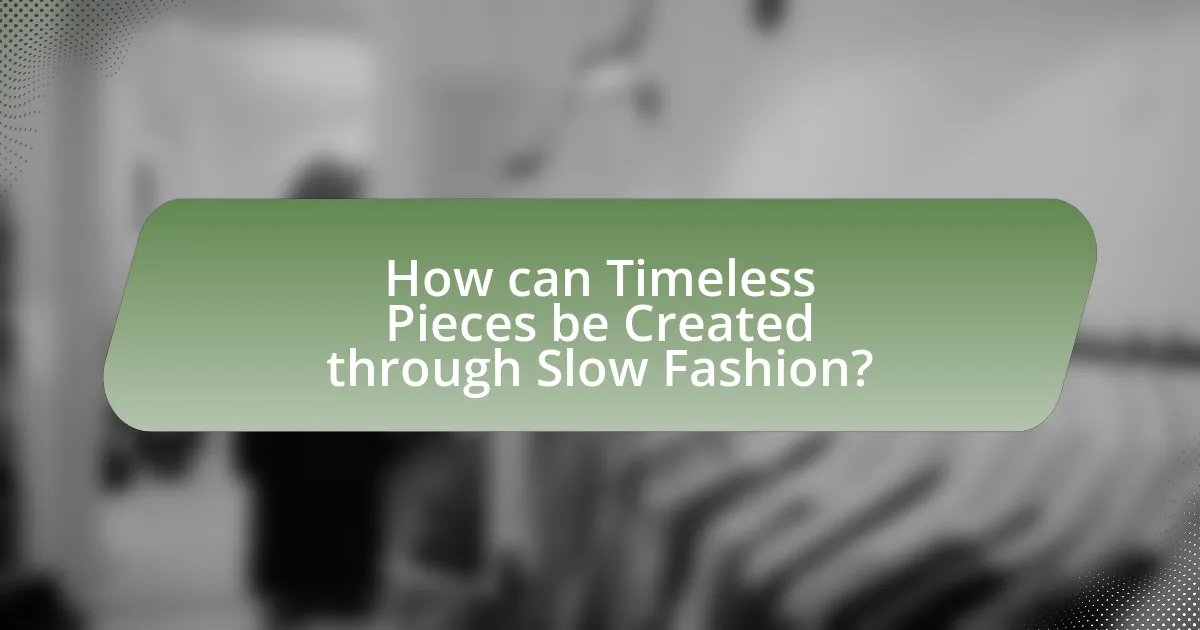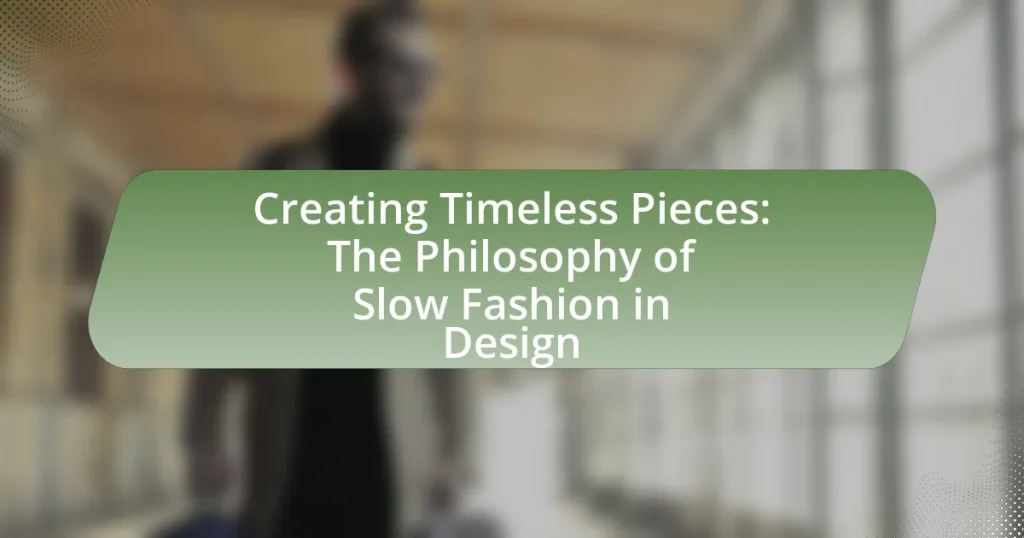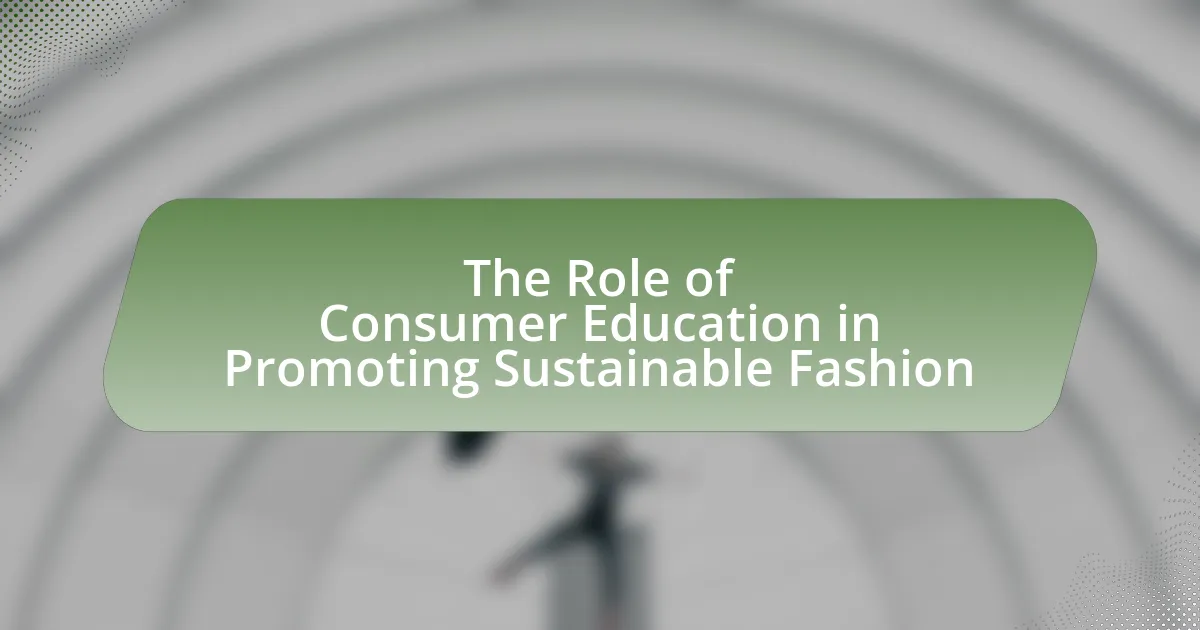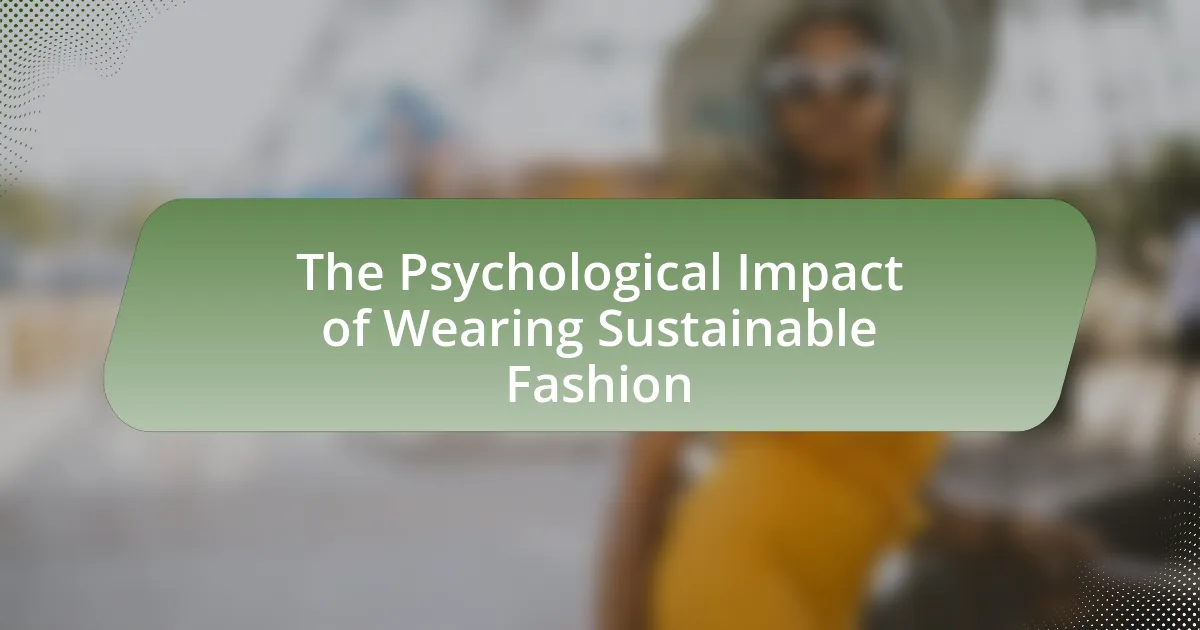The article focuses on the philosophy of Slow Fashion in design, which prioritizes sustainability, quality, and ethical production over fast fashion’s rapid consumerism. It outlines the key principles of Slow Fashion, including the importance of durable garments, eco-friendly materials, and fair labor practices, while contrasting these with the detrimental impacts of fast fashion. The article also explores the historical roots of Slow Fashion, the influence of consumer behavior and cultural shifts, and the challenges and opportunities faced by designers in adopting these principles. Additionally, it discusses how timeless pieces can be created through thoughtful design, the role of materials and craftsmanship, and practical steps consumers can take to support the Slow Fashion movement.

What is the Philosophy of Slow Fashion in Design?
The philosophy of slow fashion in design emphasizes sustainability, quality, and ethical production over fast-paced consumerism. This approach advocates for creating garments that are durable, timeless, and made with environmentally friendly materials, thereby reducing waste and promoting responsible consumption. Slow fashion encourages designers to consider the entire lifecycle of a product, from sourcing materials to labor practices, ensuring that each piece contributes positively to both society and the environment. This philosophy is supported by the growing awareness of the negative impacts of fast fashion, which has led to a shift in consumer preferences towards more sustainable and ethical choices in the fashion industry.
How does Slow Fashion differ from Fast Fashion?
Slow Fashion emphasizes sustainability, quality, and ethical production, while Fast Fashion prioritizes rapid production, low cost, and trend-driven designs. Slow Fashion promotes the creation of durable garments that are made to last, often using eco-friendly materials and fair labor practices, which contrasts sharply with Fast Fashion’s model of producing inexpensive, disposable clothing that quickly goes out of style. According to a 2020 report by the Ellen MacArthur Foundation, the Fast Fashion industry contributes significantly to environmental degradation, with an estimated 92 million tons of textile waste generated annually, highlighting the unsustainable nature of this approach compared to the more responsible practices of Slow Fashion.
What are the key principles of Slow Fashion?
The key principles of Slow Fashion include sustainability, ethical production, and timeless design. Sustainability emphasizes the use of eco-friendly materials and processes that minimize environmental impact, while ethical production focuses on fair labor practices and transparency in the supply chain. Timeless design advocates for creating clothing that transcends seasonal trends, encouraging consumers to invest in quality pieces that last longer. These principles collectively aim to reduce waste and promote a more responsible approach to fashion consumption.
Why is sustainability important in Slow Fashion?
Sustainability is important in Slow Fashion because it emphasizes ethical production practices that minimize environmental impact and promote social responsibility. Slow Fashion prioritizes quality over quantity, encouraging consumers to invest in durable, timeless pieces rather than disposable clothing. This approach reduces waste and pollution, as evidenced by the fashion industry being responsible for 10% of global carbon emissions and significant water usage. By adopting sustainable practices, Slow Fashion contributes to a more responsible industry that values both the planet and the people involved in the production process.
What are the historical roots of Slow Fashion?
The historical roots of Slow Fashion can be traced back to the early 20th century, particularly in response to the rise of mass production and fast fashion. The movement emphasizes sustainable practices, quality craftsmanship, and ethical production methods, which were prevalent in traditional garment-making before industrialization. In the 1960s and 1970s, countercultural movements began advocating for more sustainable and ethical consumption, laying the groundwork for Slow Fashion. The term “Slow Fashion” itself emerged in the early 2000s, popularized by designers like Kate Fletcher, who highlighted the environmental and social impacts of the fashion industry. This historical context underscores a shift towards valuing quality over quantity, aligning with broader sustainability goals.
How did consumer behavior influence the rise of Slow Fashion?
Consumer behavior significantly influenced the rise of Slow Fashion by shifting towards sustainability and ethical consumption. As consumers became more aware of the environmental and social impacts of fast fashion, they began to prioritize quality over quantity, seeking brands that align with their values. This change is evidenced by a 2020 survey from McKinsey & Company, which found that 67% of consumers consider the use of sustainable materials important when making a purchase. Consequently, brands adapted their practices to meet this demand, leading to the growth of Slow Fashion as a response to consumer preferences for timeless, durable pieces that promote responsible production.
What cultural shifts have contributed to the Slow Fashion movement?
The Slow Fashion movement has been significantly influenced by cultural shifts towards sustainability, ethical consumerism, and a growing awareness of environmental issues. These shifts have led consumers to prioritize quality over quantity, seeking garments that are made to last and produced in environmentally friendly ways. For instance, the rise of social media has facilitated the spread of information regarding the negative impacts of fast fashion, prompting consumers to demand transparency and ethical practices from brands. Additionally, movements advocating for minimalism and conscious living have encouraged individuals to reduce consumption and invest in timeless, versatile pieces rather than disposable fashion. This cultural evolution reflects a broader societal commitment to sustainability and responsible consumption, which is foundational to the principles of Slow Fashion.

How can Timeless Pieces be Created through Slow Fashion?
Timeless pieces can be created through slow fashion by prioritizing quality, sustainability, and craftsmanship over fast trends. Slow fashion emphasizes the use of durable materials and ethical production methods, which contribute to the longevity of garments. For instance, brands that focus on artisanal techniques and limited production runs often produce items that withstand changing fashion cycles, thereby becoming wardrobe staples. Research indicates that consumers are increasingly valuing sustainability, with a 2021 survey showing that 66% of global respondents are willing to pay more for sustainable brands. This shift supports the slow fashion movement, reinforcing the idea that investing in well-made, timeless pieces is both environmentally responsible and economically viable.
What defines a Timeless Piece in fashion design?
A timeless piece in fashion design is defined by its enduring appeal, versatility, and quality craftsmanship. These garments transcend seasonal trends and remain relevant across different eras, often characterized by classic silhouettes, neutral colors, and high-quality materials. For example, the little black dress, popularized by Coco Chanel in the 1920s, continues to be a staple in women’s wardrobes due to its adaptability and elegance. Timeless pieces are also often associated with sustainable practices, as they encourage consumers to invest in long-lasting items rather than fast fashion, aligning with the principles of slow fashion.
How do materials and craftsmanship contribute to timelessness?
Materials and craftsmanship significantly contribute to timelessness by ensuring durability and aesthetic appeal. High-quality materials, such as natural fibers and sustainably sourced woods, resist wear and maintain their integrity over time, while skilled craftsmanship enhances the design through attention to detail and superior construction techniques. For instance, garments made from organic cotton or wool not only provide comfort but also age gracefully, often becoming more desirable as they develop character. Historical examples include iconic fashion pieces like the Chanel suit, which remains relevant due to its classic design and the use of premium materials. This combination of quality materials and expert craftsmanship creates products that transcend trends, embodying a lasting value that resonates with consumers seeking sustainability and longevity in their purchases.
What role does design philosophy play in creating timeless pieces?
Design philosophy is crucial in creating timeless pieces as it establishes a foundational approach that prioritizes sustainability, functionality, and aesthetic value. This philosophy encourages designers to focus on quality materials and craftsmanship, which contribute to the longevity of the piece. For instance, the principles of slow fashion advocate for thoughtful design processes that resist fleeting trends, thereby fostering enduring appeal. Historical examples, such as the Bauhaus movement, illustrate how a strong design philosophy can lead to iconic, lasting designs that remain relevant across generations.
How can designers implement Slow Fashion principles?
Designers can implement Slow Fashion principles by prioritizing sustainable materials, ethical production methods, and timeless designs. By selecting organic, recycled, or locally sourced fabrics, designers reduce environmental impact and support local economies. Ethical production involves ensuring fair labor practices and transparency in the supply chain, which fosters social responsibility. Additionally, creating timeless designs that transcend seasonal trends encourages consumers to invest in quality pieces that last, thereby reducing waste. Research indicates that the fashion industry is responsible for 10% of global carbon emissions, highlighting the need for sustainable practices. Implementing these principles not only aligns with environmental goals but also meets the growing consumer demand for responsible fashion.
What are the best practices for sourcing sustainable materials?
The best practices for sourcing sustainable materials include prioritizing renewable resources, ensuring ethical labor practices, and selecting materials with low environmental impact. Companies should focus on using organic, recycled, or upcycled materials, as these options reduce waste and resource depletion. For instance, organic cotton uses 91% less water than conventional cotton, highlighting its sustainability. Additionally, sourcing from suppliers who adhere to fair trade principles ensures that workers are treated ethically, which is crucial for sustainable practices. Implementing life cycle assessments can also help businesses evaluate the environmental impact of materials throughout their life span, guiding them toward more sustainable choices.
How can designers balance aesthetics and functionality in their creations?
Designers can balance aesthetics and functionality by integrating user-centered design principles with visual appeal. This approach ensures that the end product not only looks good but also meets the practical needs of users. For instance, the use of ergonomic shapes in furniture design enhances comfort while maintaining an attractive appearance. Research shows that products designed with both aesthetics and functionality in mind tend to have higher user satisfaction rates, as evidenced by a study published in the Journal of Design Research, which found that 75% of consumers prioritize both elements in their purchasing decisions.

What are the Challenges and Opportunities in Slow Fashion Design?
The challenges in slow fashion design include higher production costs, limited scalability, and consumer awareness, while opportunities encompass sustainability, niche market growth, and fostering a deeper connection between consumers and products. Higher production costs arise from the use of quality materials and ethical labor practices, which can deter mass-market appeal. Limited scalability is evident as slow fashion brands often struggle to compete with fast fashion’s rapid production cycles. However, the growing consumer demand for sustainable practices presents an opportunity for slow fashion to thrive, with a market projected to reach $8.25 billion by 2023, according to a report by Research and Markets. Additionally, slow fashion fosters a deeper connection between consumers and products, encouraging mindful purchasing and long-term investment in quality items.
What obstacles do designers face in adopting Slow Fashion?
Designers face several obstacles in adopting Slow Fashion, primarily including higher production costs, limited consumer demand, and the challenge of changing established industry practices. Higher production costs arise from the use of sustainable materials and ethical labor practices, which can significantly increase the price of garments compared to fast fashion alternatives. Limited consumer demand is evident as many consumers prioritize low prices and quick trends over sustainability, making it difficult for designers to justify the investment in Slow Fashion. Additionally, the challenge of changing established industry practices is significant, as many designers are entrenched in fast fashion cycles that prioritize speed and volume over quality and sustainability. These obstacles collectively hinder the widespread adoption of Slow Fashion principles in the design industry.
How can designers overcome consumer skepticism about Slow Fashion?
Designers can overcome consumer skepticism about Slow Fashion by transparently communicating the environmental and social benefits of their practices. By providing clear information on sourcing materials, production processes, and the positive impact on local communities, designers can build trust with consumers. For instance, studies show that 66% of consumers are willing to pay more for sustainable brands, indicating a market readiness for Slow Fashion when its value is effectively communicated. Additionally, showcasing certifications and partnerships with ethical organizations can further validate claims and enhance credibility.
What are the economic implications of Slow Fashion for designers?
The economic implications of Slow Fashion for designers include increased production costs and potential for higher profit margins through premium pricing. Designers adopting Slow Fashion often invest in sustainable materials and ethical labor practices, which can raise initial expenses. However, this approach allows them to market their products as high-quality and environmentally friendly, enabling them to charge more. For instance, a study by the Ellen MacArthur Foundation highlights that consumers are willing to pay up to 20% more for sustainable fashion items. Additionally, Slow Fashion fosters brand loyalty and repeat customers, which can lead to long-term financial stability.
What opportunities does Slow Fashion present for innovation?
Slow Fashion presents opportunities for innovation by promoting sustainable practices, encouraging the use of eco-friendly materials, and fostering local craftsmanship. This approach allows designers to explore new techniques and technologies that reduce waste and enhance product longevity. For instance, the adoption of biodegradable fabrics and zero-waste pattern-making can lead to significant reductions in environmental impact. Additionally, Slow Fashion encourages transparency in supply chains, which can drive innovation in traceability technologies, such as blockchain, to ensure ethical sourcing. These innovations not only align with consumer demand for sustainability but also create new market niches focused on quality and durability over fast consumption.
How can technology enhance the Slow Fashion movement?
Technology can enhance the Slow Fashion movement by enabling sustainable production practices and improving transparency in the supply chain. For instance, advancements in digital design tools allow designers to create patterns and prototypes more efficiently, reducing waste associated with traditional sampling methods. Additionally, blockchain technology can provide consumers with verifiable information about the origins of materials and the ethical practices of manufacturers, fostering trust and accountability. A study by the Ellen MacArthur Foundation highlights that digital technologies can significantly reduce resource consumption and waste in the fashion industry, aligning with the principles of Slow Fashion.
What role do collaborations play in promoting Slow Fashion?
Collaborations play a crucial role in promoting Slow Fashion by fostering innovation and sustainability through shared resources and expertise. When brands, designers, and artisans collaborate, they can combine their strengths to create high-quality, timeless pieces that emphasize ethical production practices. For instance, partnerships between established fashion houses and local artisans can lead to the revival of traditional craftsmanship, which is a core principle of Slow Fashion. This approach not only enhances the uniqueness of the products but also supports local economies and reduces environmental impact by prioritizing quality over quantity. Additionally, collaborations often result in increased visibility for Slow Fashion initiatives, as they can leverage each partner’s audience to spread awareness about sustainable practices and the importance of mindful consumption.
What practical steps can consumers take to support Slow Fashion?
Consumers can support Slow Fashion by prioritizing quality over quantity in their clothing purchases. This means choosing garments made from sustainable materials, produced ethically, and designed to last. For instance, according to a 2020 report by the Ellen MacArthur Foundation, extending the life of clothing by just nine months can reduce carbon, water, and waste footprints by around 20-30%. Additionally, consumers can buy from local artisans and brands that emphasize craftsmanship, which not only supports local economies but also reduces the environmental impact associated with long-distance shipping. Engaging in second-hand shopping and clothing swaps further promotes sustainability by extending the lifecycle of garments. By making these conscious choices, consumers actively contribute to the Slow Fashion movement.
How can consumers identify and choose timeless pieces?
Consumers can identify and choose timeless pieces by focusing on quality, versatility, and classic design. High-quality materials and craftsmanship ensure durability, while versatile items can be styled in multiple ways, making them suitable for various occasions. Classic designs, which often transcend trends, include elements that remain aesthetically pleasing over time. For instance, a well-tailored blazer or a little black dress has been staples in fashion for decades, illustrating the enduring appeal of such pieces. By prioritizing these characteristics, consumers can make informed choices that align with the principles of slow fashion, which emphasizes sustainability and longevity in design.
What are the benefits of investing in Slow Fashion for consumers?
Investing in Slow Fashion offers consumers several benefits, including higher quality garments, sustainability, and unique style. Slow Fashion emphasizes craftsmanship and durable materials, resulting in clothing that lasts longer than fast fashion alternatives. This longevity reduces the frequency of purchases, ultimately saving consumers money over time. Additionally, Slow Fashion promotes ethical production practices, which align with the values of environmentally conscious consumers. According to a 2020 report by the Ellen MacArthur Foundation, the fashion industry is responsible for 10% of global carbon emissions; thus, choosing Slow Fashion can significantly reduce one’s carbon footprint. Furthermore, Slow Fashion often features unique designs, allowing consumers to express individuality rather than conforming to mass-market trends.




